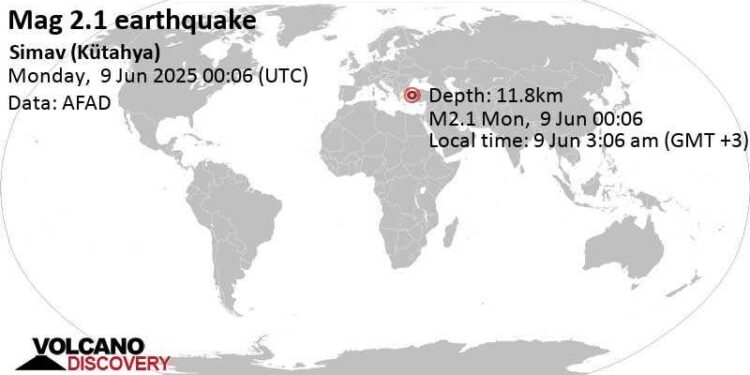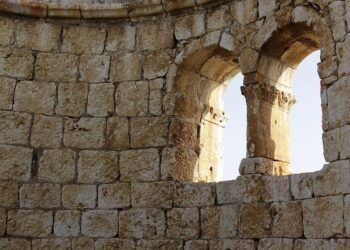A 4.5 magnitude earthquake shook the city of Kutahya earlier today, according to local authorities. Despite the moderate tremor felt across the region, no casualties or significant damage have been reported. Emergency services swiftly assessed the situation, reassuring residents as aftershocks continue to be monitored. This event serves as a reminder of TĂĽrkiye’s seismic activity and the importance of preparedness in vulnerable areas.
Kutahya Experiences Moderate Earthquake with Minimal Impact
A 4.5 magnitude earthquake shook the province of Kutahya earlier today, causing brief alarm among residents but ultimately leaving no injuries or significant damage in its wake. The epicenter was located just a few kilometers outside the city center, resulting in mild tremors felt across nearby towns. Emergency services responded promptly, conducting thorough inspections of critical infrastructure and residential buildings to ensure public safety.
Local authorities have outlined key observations and steps taken following the event:
- No casualties or serious injuries have been reported since the earthquake struck.
- Minor structural impacts were noted in some older buildings, but none pose immediate risk.
- Ongoing monitoring by seismic experts has been intensified to track any aftershocks.
- Public reassurances focused on calm and preparedness in case of further seismic activity.
| Details | Information |
|---|---|
| Magnitude | 4.5 |
| Epicenter Location | 5 km NW of Kutahya |
| Time of Occurrence | 09:35 AM Local Time |
| Casualties | None |
| Damage Level | Minimal |
Assessing Seismic Activity in Western TĂĽrkiye and Preparedness Measures
Western TĂĽrkiye, notably the region around KĂĽtahya, remains a zone of notable seismic activity due to its proximity to several active fault lines, including those linked to the North Anatolian Fault system. The recent 4.5 magnitude earthquake serves as a stark reminder of the area’s vulnerability, although the absence of casualties demonstrates the positive impact of ongoing preparedness and resilient infrastructure. Experts emphasize that while such moderate tremors are common, continuous monitoring and early warning systems play a critical role in minimizing damage and ensuring public safety.
In light of recent events, local authorities and communities have been encouraged to reinforce their readiness through specific measures. Key preparedness strategies include:
- Regular earthquake drills in schools and workplaces to foster quick, coordinated responses.
- Public awareness campaigns leveraging social media and local broadcasts to educate citizens on seismic safety.
- Retrofitting older buildings to meet modern seismic codes, reducing risk in future events.
- Improved emergency response coordination between municipal services and national disaster agencies.
| Preparedness Measure | Status in KĂĽtahya | Impact |
|---|---|---|
| Early Warning System | Fully operational | Provides alerts within seconds |
| Public Drills | Quarterly | Improved community response time |
| Building Retrofitting | 60% completed | Lower risk of structural damage |
| Emergency Supplies | Available in all districts | Quick aid deployment |
Community Safety Guidelines and Emergency Response Recommendations for Earthquake Zones
In regions prone to seismic activity, understanding and implementing community safety measures can dramatically reduce risks and protect lives during an earthquake. Residents are encouraged to establish clear communication plans with family and neighbors to ensure swift information sharing in the aftermath of a tremor. It is essential to secure heavy furniture and appliances, keeping emergency kits with water, food, and first aid supplies readily accessible. Familiarity with safe spots inside homes, such as underneath sturdy tables or against interior walls away from windows, can be lifesaving during sudden shakes.
Emergency responders and local authorities recommend practicing earthquake drills regularly and reviewing evacuation routes within communities. Below is a quick-reference table outlining immediate actions to take before, during, and after an earthquake to maximize safety:
| Phase | Recommended Actions |
|---|---|
| Before | Secure furniture, prepare emergency kit, create family plan |
| During | Drop, cover, and hold on; avoid windows and heavy objects |
| After | Check for injuries, listen to updates, cautiously evacuate if needed |
In Conclusion
Authorities continue to monitor the situation closely as aftershocks remain a possibility in the region. While the 4.5 magnitude earthquake in Kutahya caused no reported injuries or significant damage, residents are advised to stay prepared and follow official guidelines. Updates will be provided as more information becomes available.
















